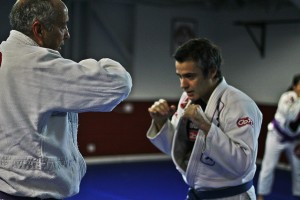Flow With The Go: how flow rolling can help you develop your game
If I told you that there was a training method that could help you develop both the weakest and strongest areas of your game at the same time would you be interested?
Heard of the bjj expression “Keep it playful”? Flow rolling is a method of sparring that occurs at a lighter, less competitive / more cooperative pace than the regular rolling, involving a give and take in the match where your opponent is allowed to apply their techniques without your full defence and the emphasis is on movement and the exchange of positions.
During most rolling each participant is trying to impose their game on the opponent with little allowance for the opponent to effect their own techniques. A strength of BJJ rolling is this application of your techniques against a fully resisting opponent at a high intensity, giving the practitioner confidence in their ability to realistically apply their jiu-jitsu.
There is however also a limitation to full intensity sparring (especially with evenly matched opponents) where each person will avoid taking chances or trying a new technique for fear of losing position and ending up getting submitted.
This is where flow rolling will loosen up your game. Here are 4 ways that flow rolling can improve your jiu-jitsu. Bear in mind that the primary purpose of training is to develop your jiu-jitsu, not compete like the Mundials final every roll!
1) Try new positions / develop your weaker positions
One of the ways one is discouraged from incorporating new positions or even attempting to improve your weaker positions is the fear that when your opponent counters the technique, you will lose your position on possibly get submitted. So you tighten up your game and instead restrict yourself to only  your tried and true best techniques.
your tried and true best techniques.
But you have failed to try to incorporate that new position into your game and over a period this stifles your progress and growth.
With the cooperative nature of flow rolling you can attempt your triangle and your opponent allows you to lock it up before he starts the correct counter. With repeated attempts in flow rolling, you gain confidence in your ability to apply the triangle and have both added a new submission to your arsenal and corrected a weak spot in your game.
2) Exchange of many different positions
During a 5 min round of intense sparring, each person will attempt to limit the movement of their opponent and control the positions. This results in static matches where each tightens their grips and the movement between positions grinds to a halt.
It is not uncommon to see some competition matches where both combatants are locked in a half guard for the entire duration of the match!
It is unfortunate if you are eager to try that new bow and arrow choke that you learned in class this week, but you might not see a single opportunity in the entire round to attempt it.
Instead, in flow rolling, you have the option to direct the roll repeatedly to the back position and try choke as many times as you wish. Repetition is the mother of skill and this a great way to get those reps in and make that technique part of your game.
3) Learning opponent reactions
Marcelo Garcia said that a key to getting deadly at submissions was to allow a tight, defensive opponent to move, thereby opening up opportunities for submissions.
By the time most bjjers are at bluebelt, they have some idea of their best positions. To bring their level up higher in those already strong positions, flow rolling will build your transitions to get to those strong positions and also build your knowledge of how your opponent counters.
 When you have a solid idea of how the opponent will counter your favourite technique you can now anticipate their reactions, start to build combinations and recounters and thus always be one step ahead of your opponent’s defence.
When you have a solid idea of how the opponent will counter your favourite technique you can now anticipate their reactions, start to build combinations and recounters and thus always be one step ahead of your opponent’s defence.
The next time you secure your favourite position, allow the opponent space to escape and ask yourself “Which complimentary technique are they now vulnerable to? How can I chain together multiple submission threats?”
4) Training around injuries
One of the unfortunate realities of bjj is dealing with training injuries. It can be frustrating to sit on the sidelines as you recover and feel that your hard won progress is slipping away.
Injuries must be allowed to heal completely before resuming high intensity sparring or you run the risk of re injuring and further setting back your return to the mat.
Training around injuries is a skill to keep your jiu-jitsu progressing and providing some mental relief from the frustration of being sidelined.
High intensity sparring involves sudden, uncontrolled movements where you are unexpectedly forced to post a hand or shift balance onto your knee to avoid being swept.
Flow rolling will allow you to avoid certain positions that aggravate your injury and still retain your timing and movement.
Credits: Mark Mullen
GB Black belt from GB GB Calgary-Canada
Twitter: @MarkMullenBJJ

